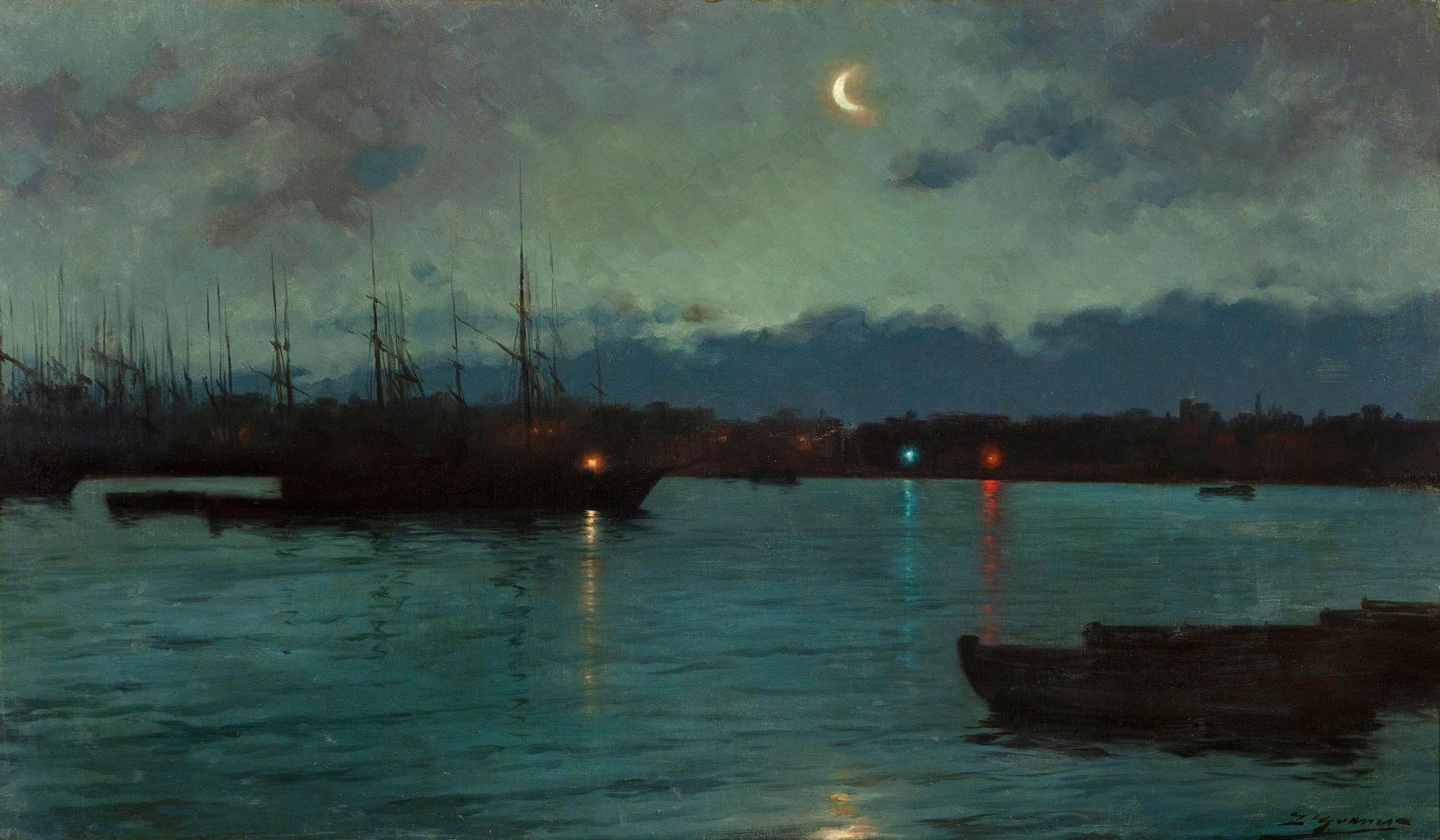Description
LUIS GRANER ARRUFÍ (Barcelona, 1863 - 1929). "Night-time Marina. Port of Barcelona". Oil on canvas. Signed in the lower right corner. Carved and gilded wooden frame. Measurements: 57 x 97 cm; 89 x 128 cm (frame). The light was the great protagonist of Lluís Graner's work, both in his interior paintings, where a quinque often illuminates the faces congregated in the half-light of the home, and in coastal landscapes like the one we are dealing with, where a lunar light subtly reverberates on the nocturnal sea of Barcelona. The boats in the port are silhouetted with their tall masts against an indigo blue bathed in silver. The city skyline is also outlined against the light, so that its blackness contrasts with the rippling surface of the water. Luis Graner trained at the La Lonja School in Barcelona, where he was a pupil of Benito Mercadé and Antonio Caba, and in 1886 he moved to Paris thanks to a grant from the Diputació de Barcelona. During his five years in the French capital he won two third place medals at the Universal Exhibitions of Barcelona (1888) and Paris (1889). When he returned to Barcelona in 1891, he continued to take part in important international exhibitions, such as those of Berlin (1891), Munich (1892) and Düsseldorf (1904). He also submitted works to the National Fine Arts Exhibitions, winning third medals in 1895 and 1897, second in 1901 and a decoration in 1904. That same year Graner created the Sala Mercè, designed by Gaudí, where he organised his "musical visions", shows that combined poetry with music, scenography with cinema. Collaborating with him at this stage were Adrià Gual as director of the performances and Segundo de Chomón, as well as well-known poets (Verdaguer, Carner), musicians (Morera, Lambert) and contemporary stage designers (Moragas, Alarma). At the same time, Graner organised the first talkies, using the technique of placing actors behind the screen to lend their voices. Finally, ruined, he moved to America, where he devoted himself once again to painting. He made several trips around the United States and Latin America, spending most of his time between New York, where he painted his first solo exhibition in 1891, and California. In 1927 he returned to Barcelona shortly before his death. His paintings, realistic in form, depict the everyday life of humble people, although he also painted landscapes and portraits. In his interior scenes he showed a profound influence of Latour, learned in his Parisian years, which led him to focus on the expressiveness of artificial light. Specialising in genre painting, he also produced landscapes and portraits. His work can be found in the Prado Museum, the MACBA in Barcelona, the National Art Museum of Catalonia, the Hispanic Society in New York and the Balaguer Museum in Vilanova i la Geltrú, among others, as well as in important private Catalan collections.
56
LUIS GRANER ARRUFÍ (Barcelona, 1863 - 1929). "Night-time Marina. Port of Barcelona". Oil on canvas. Signed in the lower right corner. Carved and gilded wooden frame. Measurements: 57 x 97 cm; 89 x 128 cm (frame). The light was the great protagonist of Lluís Graner's work, both in his interior paintings, where a quinque often illuminates the faces congregated in the half-light of the home, and in coastal landscapes like the one we are dealing with, where a lunar light subtly reverberates on the nocturnal sea of Barcelona. The boats in the port are silhouetted with their tall masts against an indigo blue bathed in silver. The city skyline is also outlined against the light, so that its blackness contrasts with the rippling surface of the water. Luis Graner trained at the La Lonja School in Barcelona, where he was a pupil of Benito Mercadé and Antonio Caba, and in 1886 he moved to Paris thanks to a grant from the Diputació de Barcelona. During his five years in the French capital he won two third place medals at the Universal Exhibitions of Barcelona (1888) and Paris (1889). When he returned to Barcelona in 1891, he continued to take part in important international exhibitions, such as those of Berlin (1891), Munich (1892) and Düsseldorf (1904). He also submitted works to the National Fine Arts Exhibitions, winning third medals in 1895 and 1897, second in 1901 and a decoration in 1904. That same year Graner created the Sala Mercè, designed by Gaudí, where he organised his "musical visions", shows that combined poetry with music, scenography with cinema. Collaborating with him at this stage were Adrià Gual as director of the performances and Segundo de Chomón, as well as well-known poets (Verdaguer, Carner), musicians (Morera, Lambert) and contemporary stage designers (Moragas, Alarma). At the same time, Graner organised the first talkies, using the technique of placing actors behind the screen to lend their voices. Finally, ruined, he moved to America, where he devoted himself once again to painting. He made several trips around the United States and Latin America, spending most of his time between New York, where he painted his first solo exhibition in 1891, and California. In 1927 he returned to Barcelona shortly before his death. His paintings, realistic in form, depict the everyday life of humble people, although he also painted landscapes and portraits. In his interior scenes he showed a profound influence of Latour, learned in his Parisian years, which led him to focus on the expressiveness of artificial light. Specialising in genre painting, he also produced landscapes and portraits. His work can be found in the Prado Museum, the MACBA in Barcelona, the National Art Museum of Catalonia, the Hispanic Society in New York and the Balaguer Museum in Vilanova i la Geltrú, among others, as well as in important private Catalan collections.
